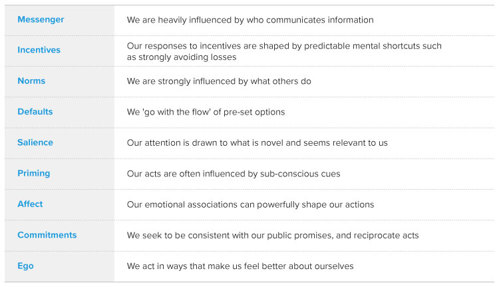Frontline workers are often the last people to hear about change but the first to be impacted by it. This blog discusses the research behind strategic messengers for frontline employees, the MINDSPACE behavior change model, and scenarios to help you visualize these dynamics in action and put them into practice.
We have a lot of names for frontline workers and a sporadic track record for how we communicate with them. In the early days of the pandemic, essential workers like medical care teams in the healthcare field became frontpage news, however the frontline workforce in retail, transportation workers, food service, and manufacturing also set the stage perfectly for a discussion about the inevitable gap between corporate communications and frontline employees.
Frontline workers are often the last people to hear about change but the first to be impacted by it. When managing change in your organization, consider that the experiences, preferred communication channels, and trusted messengers of your frontline workers are often the difference between a smooth adoption and significant disruptions. This blog discusses the research behind strategic messengers for frontline employees, the MINDSPACE behavior change model, and scenarios to help you visualize these dynamics in action and put them into practice.
The Messenger is the Message
Imagine someone you’ve never met emails you and tells you to invest in a particular stock. There’s a chance you may casually investigate to see if it’s worth trying, but you are more likely to delete the message and forget you ever saw it, or even grow suspicious and annoyed. Now imagine that you have a financial advisor or close friend with a reputation for financial savviness who gives you the same message. You are far more likely to act on that information. Now, let’s apply that premise to frontline workers: is a nurse more likely to trust information from a distant corporate article or an internal contact they see regularly (i.e. another nurse, hospital coordinator, on-site manager, etc.) The messenger IS the message, and it is important to recognize that those in frontline fields of work are incredibly focused on specialized problem solving and teamwork which may feel worlds away from the corporate priorities of their organization. Most of us can relate to this dynamic personally in some form or another. Years ago, I worked as a barista for a large chain company. When I first started, I was assigned several online training modules that covered basic things like different drink recipes, how to use various equipment, and other procedures. These trainings were helpful to establish foundations and orient me with company priorities. Still, there was an unspoken understanding that the REAL training would come not from corporate, but from my coworkers working alongside me. The crucial and direct line of information on changes like new equipment, new technology, and new policies was our store manager, who served as a middle management liaison between corporate and us. She worked shifts alongside us and knew exactly what it was like to serve customers every day. For this reason, we trusted what she had to say. She kept us informed about what was happening at a higher level within the company, made us aware of initiatives, engaged us with leadership messages from the CEO, and provided feedback to upper management on our behalf.
Workers’ preference to hear news from a more trusted source isn’t just anecdotal; it’s backed by research and documented for frontline workers specifically:
- A 2019 study by Prosci confirmed that 70% of people prefer to receive more personal messages from a direct manager versus other news channels.
- Studies conducted jointly by the International Association of Business Communicators and Towers, Perrin, Forster & Crosby in 1980, 1982, and 1984, and TPF&C in 1990 reached the same conclusion: U.S. and Canadian employees prefer their immediate supervisors as sources of information.
- The Industrial Society found that British employees have the same preference.
- According to a 1993 study by International Survey Research, the supervisor is the preferred information source for workers throughout Europe.
- Companies’ research conducted internally over the last two decades shows the same result: Ameritech, AT&T, Cadbury Schweppes, Exxon Chemical, GE, General Tire, GM, Hewlett-Packard, and Santa Fe all found that the immediate supervisor is the preferred source of information.
So, what’s the bottom line?
The past 40 years of research spanning different sectors, countries, and companies have consistently echoed the same findings: frontline workers have clear messenger preferences!
The MINDSPACE Model of Behavioral Change
When we implement organizational changes, successful adoption almost always relies on individual behavior change. This makes behavioral science a vital factor in change management. Although the MINDSPACE model of behavior change has already been deployed with definitive results in the public policy sphere, it also has great potential when applied to organizational change management. MINDSPACE is founded on a 2010 report by the Behavioral Insights Team of the Institute for Government and Cabinet Office. The authors identified a checklist of the nine primary non-coercive influences on behavior change. When developing a change management strategy for frontline workers, each element must be accounted for, and it all starts with the messenger.

Each of these factors has the power to work in favor of your change or create resistance against it, and your choice of messenger sets the stage. Let’s shift to a scenario to see this in action.
Applying MINDSPACE to Change Management: Retail Scenario
Since I have a soft spot for coffee and personal experience working in that environment, let’s design our scenario around that. Suppose a coffee chain is rolling out a new point of sale (POS) system. The reasons for the update include greater speed, better data, and more payment options for customers. As an added bonus, the new POS is provided by the same tech company that the corporate aspect of the company relies on for its office tools and collaboration suite, allowing them to streamline contracts. Though the change will require learning new tools and will take effort to adopt, it has lots to offer for everyone involved. Depending on the change management (CM) approach, however, the rate of adoption and reception from frontline workers will be very different.
CM Approach #1
In the first approach, there is a minimal investment in change management, and the investment that is made does not focus on the frontline. There is some leadership messaging that speaks about the anticipated benefits of the change and how it fits within the company’s vision and goals. Though this information is well-received by most office workers, it does not resonate with frontline employees.
Here is a summary of the minimal change management plan for approach #1:
- Communication and training are handled separately. For the communications, an article is posted on the company intranet, and the CEO speaks about it in a town hall. However, both the town hall and the intranet article have very low visibility for the frontline workers who will be impacted.
- The messenger is not tailored. All coffee shops receive a standard notice from a corporate sender that new equipment will be installed and that training modules will be assigned to staff.
- Store managers are briefed on the change, but they are not given any specific message to cascade to their teams.
- Training modules are assigned, but they are conducted individually and not as a team. The trainers are brought in by a third party that does not already have established credibility with the employees.
If we apply a MINDSPACE lens to this situation, we can see that it may not be very effective for the frontline audience. The messenger is not influential to them, there are no clear incentives for change because communication focuses on the corporate benefits and not the benefits for baristas. Neither training nor messaging has been woven into norms on-the-job. This approach can lead to gaps in understanding, magnified resistance, low morale, and wasted time on adoption, leading to lost revenue potential.
CM Approach #2
Let’s try again. In this version, there is a more tailored strategy. A comprehensive change management plan is created instead of disparate training and communication plans. The plan’s creation involves a champions group of employees representing different impacted roles, especially the frontline workers. These champions not only help shape the plan but serve as direct lines of trusted communication for their coworkers. It is more involved, personalized, and considerate of MINDSPACE drivers.
Here is a summary of the change management plan for approach #2:
- Communication, training, and engagement are all considered parts of a larger whole.
- A champions group of representatives from impacted roles actively interfaces with the project team. Frontline workers are represented in the group so they can hear and be heard.
- Messages are tailored to each audience to emphasize their specific needs, incentives, and the benefits they can expect to see from the new POS. For example, frontline employees get messages about how it will operate with greater speed and save them time and effort inputting orders.
- In addition to top-down communication brought by CEO endorsement during the town hall, there is bottom-up communication from store managers included as champions.
- A “train the trainer” strategy allows store managers to support learning on the job, leading to a more trusted and cohesive experience for staff and fewer interruptions to everyday routines.
- Involving strategic messengers builds in trust for initial buy-in and reinforcement to sustain change.
This version of the rollout is far more considerate to those impacted. The business is statistically less likely to face resistance or delays in adoption.
Wrapping it All Up
It’s easy to get wrapped up in the technical aspects of a change, but it can come at the cost of the people impacted by it. Even in the context of thriving organizations, individuals are still influenced by the same behavioral drivers that motivate change (or resistance to it) in our personal lives. The best way to ensure value is realized is by considering the employee experience from all angles, including the messenger behind initiatives.
Valorem Reply specializes in not just finding the right technology for your unique needs and environment, but also integrating the people and process change needed to ensure success and maximum return on digital investments. If you are considering new solutions or processes for your frontline staff and want to learn more about what a change management journey might look like for you, email marketing@valorem.com to schedule a consultation with one of our change management experts.







